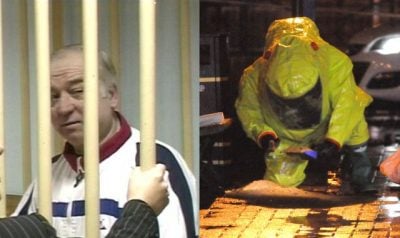Why the Russian Double-Agent Skripal Could Not Have Been Poisoned with “Novichok”

The leaders of the U.S., U.K., France and other Western countries have said they are positive that Putin’s Russia poisoned the Russian double agents living in Salisbury, the Skripals, using a deadly, military grade “Novichok” nerve agent which is of Russian origin.
But this claim falls apart upon inspection …
Specifically, the Times reported:
Stephen Davies, a consultant in emergency medicine at the Salisbury NHS Foundation Trust, said that no one other than Sergei and Yulia Skripal and Detective Sergeant Nick Bailey had needed treatment.
Dr. Davies explained:
Further to your report (“Poison exposure leaves almost 40 needing treatment”, Mar 14), may I clarify that no patients have experienced symptoms of nerve agent poisoning in Salisbury and there have only ever been three patients with significant poisoning. Several people have attended the emergency department concerned that they may have been exposed. None has had symptoms of poisoning and none has needed treatment. Any blood tests performed have shown no abnormality. No member of the public has been contaminated by the agent involved.
Indeed, all three of the three patients being treated for poisoning – Sergei Skripal, Yulia Skripal, and Detective Nick Bailey – have largely recovered.
Why is this important?
Washington’s Blog spoke with two experts on chemical weapons to find out if the facts on the ground bear out the claim that the military nerve agent Novichok was used.
Initially, the man who drafted the Biological Weapons Anti-Terrorism Act of 1989, the American implementing legislation for the 1972 Biological Weapons Convention, Francis Boyle – Professor of International Law at the University of Illinois, Champaign, with a Doctor of Law Magna Cum Laude as well as a Ph.D. in Political Science, both from Harvard University – told Washington’s Blog:
If this had been military grade nerve agent, the Skripals, the first responder policeman, and many others in the town of Salisbury where the Brits say it was spread around, would have been dead almost immediately. Yet Yulia is now apparently recovering. How did they get over to the park from their home when they should have been dead on the doorstep from contacting the agent on the doorknob?
And, Captain Doug Rokke – former Director of the U.S. Army’s Depleted Uranium Project and an expert on chemical weapons, with a PhD in health physics – told Washington’s Blog:
It is impossible to put liquid nerve agent on a door knob without trashing the entire area 100 200 meters and more radius for a long time. weeks months or more.
Any person who touched the so called exposed person would go down too.
You need level 5 ppe [i.e. personal protective equipment] and full decon [i.e. decontamination]… per fm 8-285 that is what we developed.
***
In other words … it is pure b.s.
***
The only partially useful antidote is mark 1 kit- atropine, diazapam, prodoxyaline chloride.. no good on vx tabun soman novachuk multiple 7 .
Anyone who went near this would go down anyone who touched them would go down.
Full decon is required but useless. the area for blocks around would be hot deadly.
***
If it was there you can still find it now with m8, m9, m256 kit. And anyone coming close would get zapped
And Former British intelligence officer, former UK ambassador to Uzbekistan, and Rector (i.e. Chancellor) of the University of Dundee Craig Murray writes:
The Novichok family of nerve agents are instant acting. There is no such thing as a delayed reaction nerve agent. Remember we have been specifically told by Theresa May that this nerve agent is up to ten times more powerful than VX, the Porton Down developed nerve agent that killed Kim’s brother in 15 minutes.
But if it was on the doorknob, the last contact they could possibly have had with the nerve agent was a full three hours before it took effect. Not only that, they were well enough to drive, to walk around a shopping centre, visit a pub, and then – and this is the truly unbelievable bit – their central nervous systems felt in such good fettle, and their digestive systems so in balance, they were able to sit down and eat a full restaurant meal. Only after all that were they – both at precisely the same time despite their substantially different weights – suddenly struck down by the nerve agent, which went from no effects at all, to deadly, on an alarm clock basis.
This narrative simply is not remotely credible. Nerve agents – above all “military grade nerve agents” – were designed as battlefield weapons. They do not leave opponents fighting fit for hours. There is no description in the scientific literature of a nerve agent having this extraordinary time bomb effect. Here another genuine Professor describes their fast action in Scientific American:
Unlike traditional poisons, nerve agents don’t need to be added to food and drink to be effective. They are quite volatile, colourless liquids (except VX, said to resemble engine oil). The concentration in the vapour at room temperature is lethal. The symptoms of poisoning come on quickly, and include chest tightening, difficulty in breathing, and very likely asphyxiation. Associated symptoms include vomiting and massive incontinence. Victims of the Tokyo subway attack were reported to be bringing up blood. Kim Jong-nam died in less than 20 minutes. Eventually, you die either through asphyxiation or cardiac arrest.
If the nerve agent was on the door handle and they touched it, the onset of these symptoms would have occurred before they reached the car. They would certainly have not felt like sitting down to a good lunch two hours later. And they would have been dead three weeks ago.
But that’s not what happened.
Postscript: Even if the poison were Novichok, that means absolutely nothing.
This would not be the first time that governments framed other countries in order to demonize their enemies.

